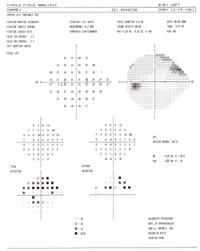
Glaucoma Treatment
and Pregnancy
BY ROBERT J. NOECKER, M.D., AND LISA HERRYGERS, M.D.
Patient history/presentation: A 31-year-old female first presented in 1993 complaining that she'd had blurry vision in her left eye for 1 week. She'd been diagnosed with iridocorneal endothelial (ICE) syndrome in her left eye 11 years earlier. Her medical history included chronic fatigue syndrome and asthma exacerbated by exercise and cold weather.
Examination: BCVA was 20/20 OD and 20/50 OS; applanation tonometry was 16 OD and 43 OS. Slit lamp examination was unremarkable OD, but corectopia and iris atrophy were present OS. Gonioscopy was unremarkable OD; six interrupted clock hours of peripheral anterior synechiae were noted OS. Indirect fundus examination revealed C/D ratios of 0.1 OD and 0.4 OS, with no focal thinning. Visual field testing was within normal limits OU.
|
|
|
|
After the patient refused treatment during breastfeeding, visual field testing revealed a superior arcuate defect,
OS. |
|
Treatment: Despite treatment with Propine, Betoptic S and Iopidine, the patient's IOP remained in the high 30s. The patient tried Diamox and Neptazane, but discontinued them because of systemic side effects. (The presence of significant peripheral anterior synechiae precluded the use of laser treatment to control IOP.)
Eventually, the patient underwent trabeculectomy OS. After surgery, her IOP remained in the high teens until 6 months later when she developed a spontaneous hyphema; this caused her IOP to increase to 28 mm Hg. However, the hyphema resolved, and her IOP returned to the high teens, with Iopidine OS, t.i.d. Visual field testing remained within normal limits during this period.
Three years later, the patient switched from Iopidine to Alphagan, and later Xalatan, but discontinued both be-cause of allergic symptoms. At this point I took her off all drops, and her IOP OS remained in the high teens.
The patient became pregnant in 1999; she presented for routine follow-up 3 months after delivery. The filtering bleb was minimally functioning, and her IOP OS was 30. How-ever, after extensive discussion of treatment options, she decided against treatment because she was nursing her baby.
Her IOP OS remained in the high 20s over the next year and a half; testing revealed development of a superior arcuate defect in her left eye (see visual field, above.) OCT3 also revealed inferotemporal thinning of the nerve fiber layer in the left eye, with normal values in the right eye.
The patient is still breastfeeding and refuses additional treatment until she stops nursing her baby.
Discussion: Treating a pregnant or lactating glaucoma patient presents a unique challenge, as most glaucoma medications are considered a possible danger to a fetus or nursing baby. The FDA rating system shown below categorizes the risk to the fetus, relative to a drug's potential benefits:
Class A: Controlled studies show no risk to fetus. No glaucoma medications fall in this category.
Class B: No evidence of risk in humans. Here, the chance of fetal harm is remote but still possible. Alphagan, Alphagan P and Propine are listed in this class; they haven't been shown to cause impaired fertility or teratogenicity in animal models. (Unfortunately, human studies are lacking.)
Class C: Risk cannot be ruled out. Teratogenicity or fetal loss has been demonstrated in animals given much higher doses than humans receive. (For ethical reasons, human studies have not been conducted, and only anecdotal evidence of a medication's safety can be found in the literature.) All glaucoma medications other than those cate- gorized as Class B fall in this category. (The one exception is Humorsol, which is classified as Class X.) The potential benefits of drugs in this category may outweigh potential risks.
Note: Prostaglandin F 2alpha, a substance found in Xalatan and Travatan, has been used to terminate pregnancy (at plasma levels much higher than those resulting from topical glaucoma medication use). These medications are generally contraindicated for a pregnant patient.
Class D: Positive evidence of risk to fetus. No glaucoma medications fall in this category.
Class X: Contraindicated in pregnancy. Humorsol is the only glaucoma drug categorized as Class X.
Most drugs are secreted in breast milk at varying concentrations relative to plasma levels, but there is very little data on the safety of glaucoma medications for lactating women. Among the facts we do know:
- Timolol, which has been shown to be concentrated in breast milk, can cause beta blockade in infants. (Despite this, the American Academy of Pediatrics has approved the use of Timolol and acetazolamide in lactating women.)
- High doses of acetazolamide and brinzolamide given to lactating rats have been shown to cause decreased weight gain and failure to thrive in offspring. However, the level of acetazolamide in breast milk is one-third the level in plasma, and infants have been shown to have low plasma levels after nursing. Nevertheless, the risk of impaired renal or hepatic function and decreased weight gain must still be considered.
- Alphagan has been shown to be excreted in rats' breast milk; however, human data is lacking. In rare cases, Alpha-gan has been shown to cause bradycardia, hypotension, hypothermia, hypotonia or apnea in neonates, so nursing infants are potentially at risk for these complications.
Robert Noecker, M.D., is an associate professor of ophthalmology at the University of Arizona in Tucson. He is also associate chair for clinical activities, director of the residency program and director of the glaucoma service. Lisa Herrygers, M.D., is a glaucoma specialist and clinical instructor of ophthalmology at the University of Arizona in Tucson.









